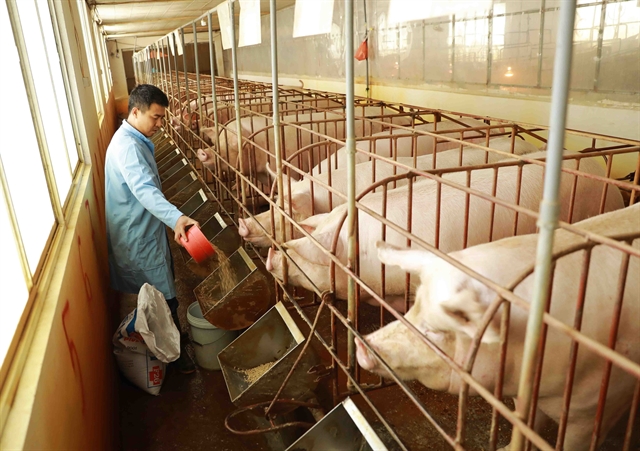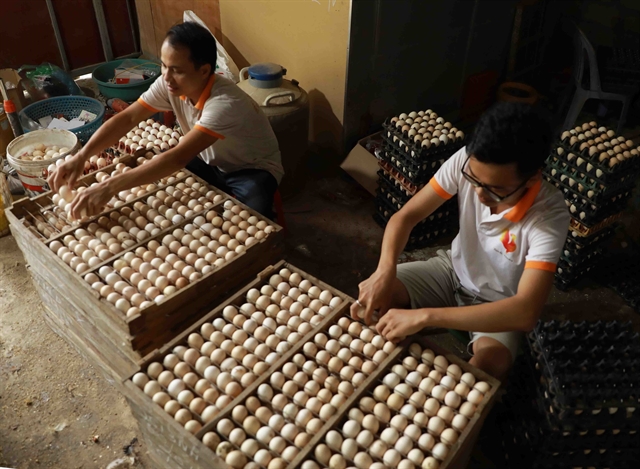 Society
Society

 |
| Nguyễn Văn Hải in Cổ Đô Commune of Ba Vì District is feeding turtles and fishes. — Photos courtesy of the Hà Nội Department of Agriculture and Rural Development |
HÀ NỘI — The Ba Vì district on the outskirts of Hà Nội in recent years has accelerated the restructuring of its agriculture in the direction of commodity production and has implemented several solutions to form concentrated production areas applying high technology to increase incomes for farmers and complete new countryside criteria.
Carrying out the agricultural restructuring programme, the district’s Party committee and government have focused on directing affiliated units to transfer and apply scientific and technical advances, and accelerate mechanisation to agricultural production.
Ba Vì District has about 15,000 households raising pigs, of which there are about 1,000 households raising them on a farm scale with a total herd of 260,000 heads.
The district has focused on restructuring the livestock sector so as to gradually reduce pig raising on a household scale in residential areas that did not ensure veterinary hygiene and disease safety.
The district’s agriculture sector introduced pig farming models applying science and technology to improve productivity, product quality as well as economic efficiency.
 |
| Herd of sows of Tạ Quang Tới in Phú Xuyên Village of Phú Châu Commune. Photos courtesy of the Hà Nội Department of Agriculture and Rural Development |
The farm of Phùng Văn Thuỵ in Cổ Đô Commune is an example.
His farm of two hectares is built and operated in a closed model, far from residential areas.
Thuỵ said that during Lunar New Year, his farm supplied the market with more than 50 tonnes of pork, earning a profit of billions of đồng. Currently, Thuỵ has a total herd of nearly 600 sows and breeding pigs and nearly 1,000 pigs. Every month, he provides tens of tonnes of safe pork and over 500 breeding pigs for breeders.
Meanwhile, Phạm Ngọc Thanh, an owner of an aquaculture farm in Phú Châu Commune, said that previously, his family specialised in raising popular fish such as tilapia, carp and driftwood.
Implementing the restructuring of the aquaculture sector in the context that supply of these fish have saturated the market, Thanh's family decided to switch to raise commercial catfish.
After more than two years of raising the fish, Thanh found that these fish are suitable for local natural conditions, raising time is from 18-24 months with a selling price of VNĐ70,000 - 80,000 (US$3-3.4) per kilo, and that brings higher economic efficiency to the family
 |
| Family members of Trương Đăng Bình in Thuỵ An Commune are screening eggs which are harvested in a chicken farm. Photos courtesy of the Hà Nội Department of Agriculture and Rural Development |
Nguyễn Giáp Đông, head of the district economic department, said that by implementing the Hà Nội Party Committee’s resolution on accelerating the National Target Programme on New Rural Construction Combining Agriculture Restructure and Rural Economic Development in the 2021-2025 period, the district’s agriculture production has been mechanised and high-tech has been applied into stages of sowing, watering, caring and harvesting.
There have been many commodity production areas, said Đông.
Specifically, the communes of Sơn Đà, Tản Hồng, Phú Cường, Chu Minh and Tiên Phong formed more than 2,000ha of high-quality rice and 168ha of safe vegetables.
Meanwhile, the hilly communes of Ba Vì, Tản Lĩnh, Minh Quang, Khánh Thượng, Vân Hòa, Yên Bài and Ba Trại developed farms of cows for beef, dairy cows, ostriches, pigs and chickens as well as large-scale farms of flowers, ornamental plants and medicinal plants while riverine areas such as the communes of Cổ Đô, Vạn Thắng, Phong Vân, Phú Đông and Phú Cường were successful in aquaculture.
 |
| Con Bò Vàng Milk Company in Tản Lĩnh Commune produces almost 60 tonnes of milk every year which are used for making fresh milk, yoghurt and cakes. Photos courtesy of the Hà Nội Department of Agriculture and Rural Development |
The district has issued a plan for developing agro-foresty-fishery by the year 2025.
Accordingly, the agriculture sector strives to reach a growth rate of 6.6 per cent per year with an agricultural economic structure of 30 per cent, while cultivation accounts for 42 per cent and livestock 58 per cent.
The district plans the development of agriculture, forestry and fishery in the direction of commodity production, bio-security and sustainability as well as agricultural development associated with new rural construction striving by 2025 to apply mechanisation to 75 per cent of production stages.
Nguyễn Văn Chí, deputy head of Hà Nội’s Co-ordinating Office of New Rural Programme, said that so far Ba Vì District has fulfilled completed the requirements of a new rural district.
Currently, Ba Vì has 30 communes recognised as meeting new rural standards, four communes meeting the newly enhanced rural standards, and Tây Đằng town recognised as a modern urban area.
As of late last year, the value of agricultural cultivation in Ba Vì reached VNĐ198 million (US$8,400) per hectare, contributing to raising the average income to VNĐ55.6 million ($2,400) per capita per year, increasing VNĐ33.9 million ($1,500) as compared to the year 2010, while the poverty rate is now 0.57 per cent, down 13.5 per cent compared to 2010.
Planned as an area for agricultural production and eco-tourism development, Ba Vì District strives to reach VNĐ220 million ($9,400) per hectare of cultivated value by 2025, and for rural people's income to reach VNĐ72 million ($3,000) per person per year.
Đỗ Quang Trung, vice chairman of the district’s People’s Committee, said that in order to fulfil the target, the district will continue to support local farmers to invest in high-tech production chains and encourage further development of organic and environment-friendly agriculture production models.
Recently, in Đông Quang commune, the Ba Vì Party Committee held a briefing session with relevant offices to discuss the progress of building new advanced rural communes and model new rural areas in 2023.
In the meeting, the district’s party secretary Dương Cao Thanh recognised and highly appreciated the results achieved by agencies and communes for the implementation of the Hà Nội Party Committee’s resolution.
Thành emphasised that communes and sectors need to continue to innovate, strengthen people and staff so as to create a strong change in awareness and action in the implementation and completion of the targets on building an enhanced new rural area and a model new rural area by 2023. VNS
* The article is published under the co-ordination of the Coordination Office of the New-Style Rural Development Programme in Hà Nội. — VNS




